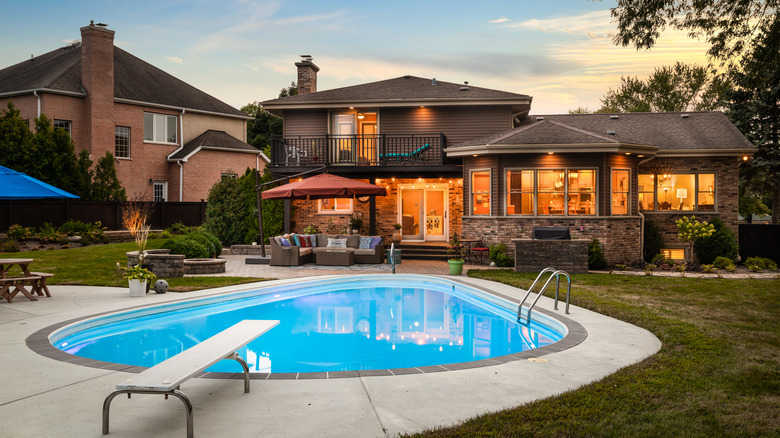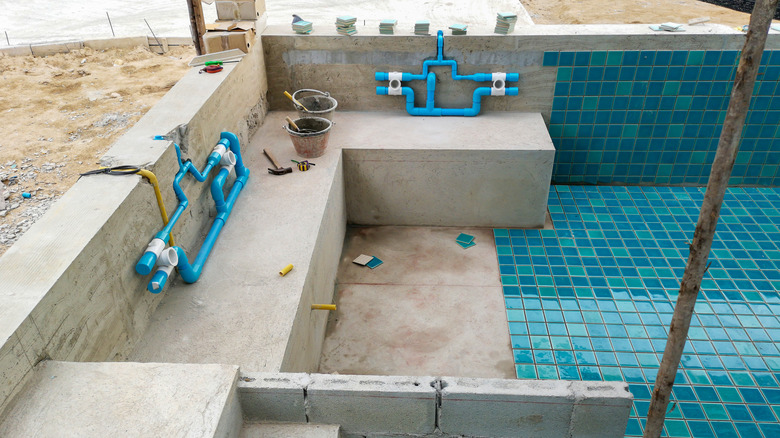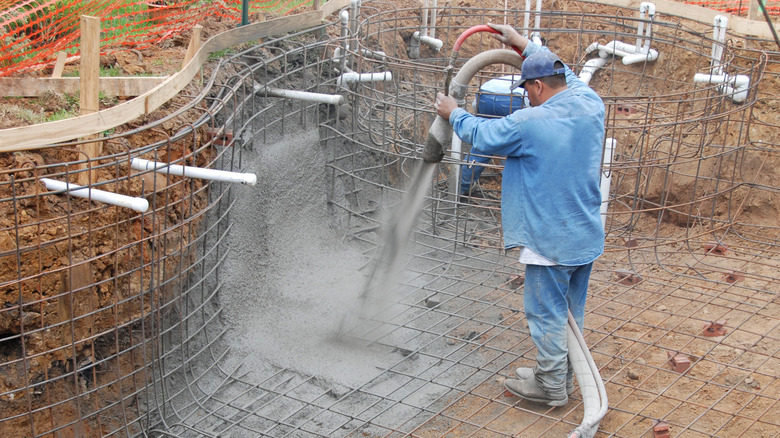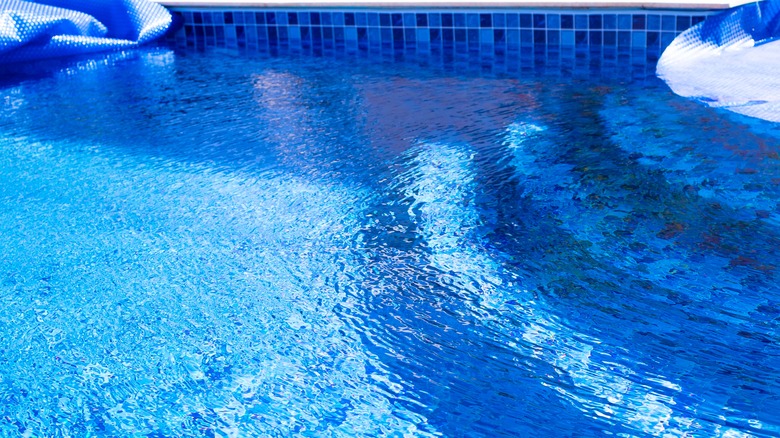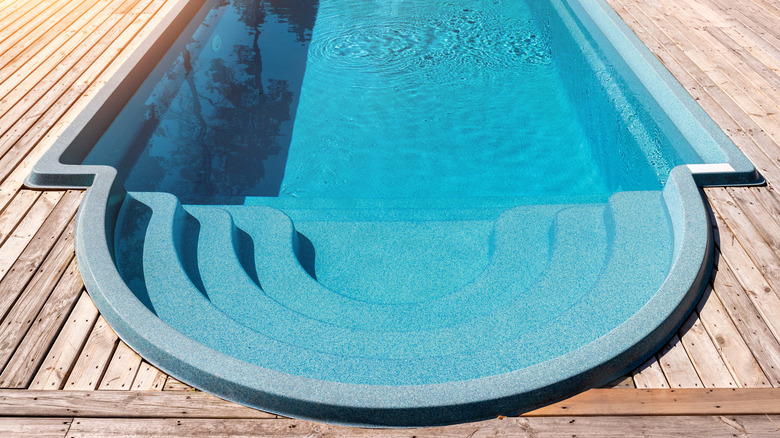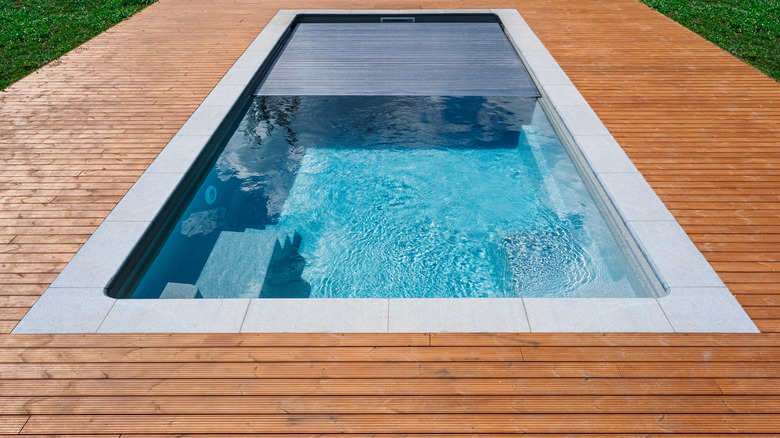The 5 Types Of Inground Pools Compared
As a homeowner, there are times that you wonder if it's worth the investment to purchase a home with an inground swimming pool in your backyard. "If you search for real estate, you will most certainly see a higher cost for homes with ready-made backyards that include pools," said Ralph DiBugnara, president of Home Qualified, in an interview with Bankrate.
Tom Casey, vice president of sales at Anthony & Sylvan Pools, added that "If you live in a warmer climate like Florida or Texas, it can increase your property value and make it more likely to sell your home." As lovely as a dip in a pool sounds, there are several factors you must consider before taking the plunge. For instance, Bob Vila notes that you need to think about maintenance, the pool's shape, location, whether or not you want to add a pool deck, and most importantly, installation methods. Read on to find out the 5 most popular types of inground pools. You can compare the styles and make the best decision for you and your family.
1. Concrete pools
According to Bob Vila, concrete pools don't come cheap. You might spend between $35,000 to $65,000 to have the pool installed and another $27,000 to $40,000 for maintenance over 10 years. Such maintenance can include acid washing the pool every 3 to 5 years and replastering the pool's surface at least once a decade, which is something to think about that can add to the overall cost. You will need to budget out tens of thousands of dollars to sufficiently afford the pool.
River Pools warns there are also some drawbacks to weigh before installing a concrete pool in your backyard. For example, saltwater pools have become increasingly popular worldwide, so if you plan on installing this option, concrete may not be the best choice. Salt is the natural enemy to concrete and will damage the pool. Concrete pools also require a considerable amount of maintenance, but even if you properly take care of it, concrete eventually breaks down and becomes rough to the touch. This can lead to scraped feet and minor injuries, so it's something to consider.
2. Gunite pools
MasterClass describes gunite pools as a type of concrete pool, but with a different application process. The mixture is sprayed into the steel base rather than poured like your typical concrete pool. This method is preferred when creating irregular shapes.
HomeGuide says that a gunite-style pool will set most people back $29,000 to $60,000, with the average homeowner shelling out about $51,000 for a pool. However, there are some additional costs that you may want to think about. The outlet explains that gunite needs to be replaced anywhere between 10 to 15 years and can cost $10,000, which is a pretty penny and something to consider if you go in this direction. A bonus to gunite is more variety when it comes to deciding pool shape. Some disadvantages are that it can take quite a long time to complete a gunite pool — up to 3 months, according to Sonco Pools & Spas.
3. Vinyl-lined pools
If you are looking for a budget-friendly option for your indoor pool, consider one that is vinyl-lined. According to Fixr, this option will run you anywhere from $35,000 to $65,000. The company notes that the national average is $45,000 for a pool that measures 12 feet by 24 feet in a rectangular configuration. This cost will include necessities such as the steps, a concrete deck, and a heater.
This price range can fluctuate depending on what kind of pool features you get. It could be as low as $20,000 for a no-frills pool, or $80,000 for a 450-square-feet lagoon-style pool with luxurious amenities that include solar heat, a diving board, and a waterfall. Seasonal World swimming pool installers note that a vinyl pool liner can generally last up to 15 years, with most owners choosing to change it between 7 and 10 years.
While vinyl-lined pools are pretty popular, they come with their own sets of cons. For example, they require regular maintenance to remove grime, can experience damage from weather-related issues, and can be damaged by sharp objects (via American Home Shield).
4. Fiberglass pools
According to Forbes Advisor, fiberglass pools may require less maintenance than other types of pools. The outlet notes that these pools can range from $20,000 for self-installation to $85,000 for all of the bells and whistles that include securing permits and implementing electrical work. Additionally, your pool's size can also determine the final cost of your pool, but on average, they cost around $52,000.
River Pools says that these pools need less maintenance than the concrete or vinyl-lined variety, which is excellent news! But that doesn't mean they're completely hands-off and maintenance-free. The company recommends that the pools stay on a regular cleaning schedule, that the filters run continuously, and that you regularly check their water chemistry to keep them clean and well-maintained. River Pools also suggests regularly cleaning any debris with a skimmer and using your pool cover to prevent leaves and bugs from getting into it.
5. Plunge pools
According to Dunk Pools, if you live in the city and have a small-scale urban backyard to go with it, a plunge pool may be your best bet for having the pool of your dreams. The company explains that this type of inground pool isn't suitable for doing laps or strenuous swimming. Instead, it's ideal for wading or relaxing with a cocktail on a hot day. These pools generally measure about 10 feet by 10 feet, so they're much smaller than your typical pool but a great option to consider if space is not on your side. Other benefits? They usually can be installed much faster than a traditional pool, which is lovely to know!
Leisure Pools USA also notes that you can use your side yard for your plunge pool, which is often a forgotten area for most homeowners. Considering it's much smaller than average, maintenance should be a breeze for city dwellers.
